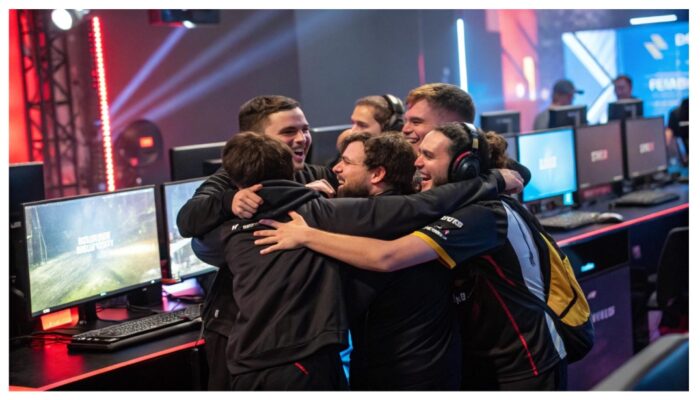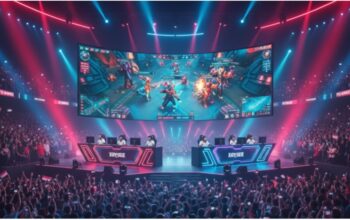Analyze current patches, map veto trends, and upset signals in League of Legends, CS2, and Dota 2. Get a match-day workflow to connect game changes to competitive outcomes.
Esports Weekly: Patch Notes, Map Picks & Upsets
Roster changes move prices. So do patches and vetoes. This weekly brief connects current patch notes with map/meta picks and upset frequency across LoL, CS2, and Dota 2. If you’re scanning pre-match pricing before lineups and vetoes land, check 1xBet odd, then verify how the week’s changes may shift pick/ban logic. The aim: facts first, a repeatable process, and quick checks you can use on match day.
Think of it as a chain: patch → draft/veto → price. Patches are the cause, drafts and vetoes are the bridge, and the odds are the effect. When those three line up, the market makes sense. When they don’t, you’ve found a tension worth watching.
What Changed This Week — At a Glance
League of Legends. The live patch nudges jungle pacing and mid-lane control tools. Faster clears often bring earlier first dragons and more support roams into the river. Teams built around proactive jungle/mid pairings can bank early objectives and force opponents into low-odds contests.
CS2. A recent update refined sub-tick movement and mapping behavior. Small notes on paper, but they touch timing, jump consistency, and utility lineups—exactly the edges that appear in pistol and first-gun rounds where precision matters most.
Dota 2. The current balance line continues to compress outlier lanes. Drafts reward flexible openers and aura-centric push timings that trade outer towers earlier, then pivot into Roshan-timed five-man looks.
Put together, expect faster early objectives in LoL, cleaner first-contact timings on a couple of CS2 maps, and more five-man accelerations in Dota 2. Keep those levers in view when you compare opener prices to closes after vetoes.
How Patches Push Prices: Cause → Effect
Patches don’t put points on the board by themselves—they alter probability drivers. A jungle change that speeds clear times shifts early objective tempo. A sub-tick tweak that smooths movement changes entry success rates on fast hits. An item buff that shortens timing windows fuels earlier tower trades and Roshan fights. You’ll see those mechanisms first in opener prices and more clearly in closing numbers once vetoes are known.
Patch Changes Most Likely to Move Markets
Direct pacing levers (jungle clear, wave control, economy timings, objective HP).
Reliability levers (projectile width, recoil curves, movement smoothing, cast ranges).
Macro incentives (objective rewards, tower durability, aura items, smoke cooldowns).
A practical habit helps: write down one pacing change, one reliability change, and one macro change that matters for the match in front of you. If those notes don’t connect to a team’s real tendencies, you probably haven’t found a driver yet.
The Live-Event Sequence Before You Look at a Price
Run the same inputs in the same order, every match day:
Start by confirming the patch ID and event rules (events can lag a patch for stability). Assess team patch fit next: did the change buff or dent a squad’s signature looks—fast A executes in CS2, dive/control pairings in LoL, or push timings in Dota 2? Consider schedule load (back-to-backs and travel shorten prep).
Move to veto patterns: which maps or first-ban champions disappear, and what comfort remains? Finally, account for side bias: CT/T splits on current CS2 maps, blue/red-side value in LoL, and Radiant/Dire plus first-pick leverage in Dota 2. Re-run the same sequence after vetoes; most price movement will make sense through that lens.
Quick Reference Sheet — Patches and Competitive Impact
Game
Current Patch Context
Competitive Impact to Watch
League of Legends
Jungle pacing & mid control tuned
Earlier first drakes; more support roams;
objective tempo shifts
CS2
Sub-tick/mapping refinements live
Entry timing reliability; utility consistency;
early-round duel stability
Dota 2
Lane outliers compressed
Flexible drafts; aura-driven pushes; earlier
tower trades & Roshan looks
Confirm that your event is actually on these versions. Some organizers adopt changes a few days late.
Map Picks and Vetoes — Where Edges Appear
Vetoes collapse uncertainty. In CS2, teams lean toward comfort maps where mid-round calls are automatic. A small movement or scripting tweak can revive previously marginal maps if the utility becomes more consistent. In LoL and Dota 2, early bans shape Tier-S options; patches that lift one role often narrow another’s pool, changing how often teams can reach favored win conditions.
Veto Tendencies to Watch This Week
CS2: Stability around the common staples; reassess first-half CT/T splits where movement changes help early hits. Watch for the return of lineups that relied on tight jump/strafe timing.
League of Legends: Jungle/mid pairings that secure first objectives gain priority; expect bans that deny tempo enablers and point-and-click control.
Dota 2: Flexible lane openers with last-pick swing preserved. Aura-centric pushes and tower-trading builds remain strong, especially in best-of-three lower-bracket series.
Bridge veto to price like this: once the pool is set, estimate pace (fast vs. slow), resource flow (objective vs. farm), and role pressure (who must answer side lanes). Then check if prices moved in line with the patch drivers you highlighted.
Upset Frequency — When Underdogs Show Up
Meta churn creates windows. Right after a patch, better prep beats raw rating more often. The first week rewards staffs with deep pools and analysts who bake movement/timing changes into set plays.
Upset Signals This WeekPatch novelty window: Teams with strong academy stacks and scrim coverage adapt first.
Veto leverage: Pool overlaps that let the underdog dodge its worst maps/comps.
Role volatility: Jungle/support shifts in LoL; utility/entry volatility in CS2; timing-dependent position fours and fives in Dota 2.
Travel & schedule compression: Short rest narrows prep; favorites feel it too.
Side/pick leverage: Blue-side priority in LoL; CT-leaning map selections in CS2; first-pick value around key heroes in Dota.
If two or more align for an underdog, expect tighter closes even when openers looked lopsided.
Case Examples You Can ReplicateCS2 — Movement Tweak → Ancient Executes.
A small change to movement smooths ladders and air-control. Teams built on fast-lane executes with tight pop timing convert early-buy rounds more often. If the favorite’s edge hinged on disrupting those timings, the gap narrows once vetoes confirm the map.
LoL — Jungle Pacing → Early Drakes.A nudge to clear speed and smite behavior raises early objective reliability. Proactive jungle/mid control banks dragons; rivals face awkward fights or concede tempo. Side selection becomes a pressure valve for the underdog.
Dota 2 — Aura Buffs → Tower Trades.An aura/item tweak accelerates five-man pushes. Lower-rated teams with clean map play can trade outers, force early glyphs, and hit a timing advantage that lifts game-one win probability.
Mobile Tracking Setup
Your plan is stronger if you can check updates on the move. After confirming patch notes and event adoption, set a quick phone workflow: follow team news feeds, enable push alerts for veto announcements, and build a shortlist of series you’ll track. For an installation page that walks through mobile setup and sign-in, download 1xBet App once you’re ready; use it to follow lineup locks and veto drops without a desktop.
This is the handoff from planning to execution: with alerts and a shortlist in place, you can check patch-fit notes against actual veto outcomes in real time.
Putting It Together on a Match Day
Use a predictable order so you’re not chasing noise. Confirm the patch and event rules first. Review the teams’ last five maps or series under the same patch with an eye on role performance: entry duels in CS2; jungle proximity and mid control in LoL; lane-pressure heroes in Dota. Then map the veto: two comfort maps for the favorite, a dodge route for the underdog. Note first-objective windows—pistol and first-gun rounds in CS2; early dragons/Herald in LoL; first Roshan in Dota. Finally, re-check closes after vetoes; movement after information explains more than openers ever will.
What to Watch Through This Weekend
Three threads to track with the current builds in play:
CS2: Do sub-tick/mapping refinements change early-round CT hold success and stabilize entry-duel outcomes on a couple of common maps? Small drifts compound across halves.
LoL: Do pick/ban tables adapt to the jungle/mid shifts, and do earlier first dragons shorten typical game-time distributions?
Dota 2: Does the compressed laning phase continue to reward five-man timing teams that trade towers cleanly and secure early Roshan control?
Closing Note
Keep the loop tight: confirm patch numbers, check event adoption, and track map-pool health each week. Start with the cause (patch), watch the bridge (veto and roles), then explain the effect (price). The pattern repeats—and that’s how you turn patch notes into a match-day edge.












